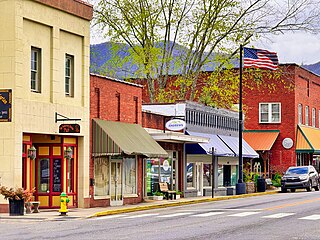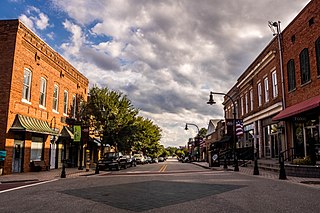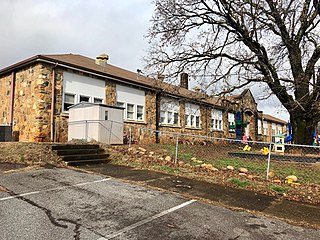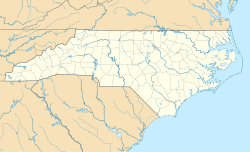
Johnston County is a county located in the U.S. state of North Carolina. As of the 2020 census, the population was 215,999. Its county seat is Smithfield.

Yanceyville is a town in and the county seat of Caswell County, North Carolina, United States. Located in the Piedmont Triad region of the state, the town had a population of 1,937 at the 2020 census.

Andrews is a town in Cherokee County, North Carolina, United States. The population was 1,667 at the 2020 census.

Hayesville is a town in Clay County, North Carolina, United States. The population was 311 at the 2010 census. It is the county seat of Clay County.

Clayton is a town in Johnston County, North Carolina, United States, and is considered a satellite town of Raleigh. As of 2020, Clayton's population was 26,307, up from 16,116 at the 2010 census. By 2024 the town's estimated population was 30,621. Much of that growth can be attributed to the town's proximity to the Research Triangle area and access to major highways such as I-40 and US 70.

Selma is a town in Johnston County, North Carolina, United States. In 2010, the population was 6,073, and as of 2018 the estimated population was 6,913. Selma is part of the Raleigh-Durham-Cary Combined Statistical Area. The area has a population over 1.7 million residents, though the town of Selma is able to maintain its rural character. The Everitt P. Stevens House, located in Selma, was the site of the last Grand Review of the Confederate Army held on April 6, 1865, after its defeat at the Battle of Bentonville.

Smithfield is a town in and the county seat of Johnston County, North Carolina, United States. As of the 2010 census, its population was 10,966, and in 2019 the estimated population was 12,985. Smithfield is home to the Ava Gardner Museum, Wild Bill's Western Town named Shadowhawk, and is situated along the Neuse River, where visitors enjoy the annual Smithfield Ham and Yam Festival, walks along the Buffalo Creek Greenway, and the historic downtown district. The town is located near North Carolina's Research Triangle and is about 30 miles (48 km) southeast of downtown Raleigh. The Raleigh-Durham-Cary combined statistical area has a population over 2 million residents.

Kinston is a city in Lenoir County, North Carolina, United States, with a population of 19,900 as of the 2020 census. It has been the county seat of Lenoir County since its formation in 1791. Kinston is located in the coastal plains region of eastern North Carolina.

Asheboro is a city in and the county seat of Randolph County, North Carolina, United States. The population was 27,156 at the 2020 census. It is part of the Greensboro-High Point Metropolitan Area of the Piedmont Triad and is home of the state-owned North Carolina Zoo.

Garner is a town in Wake County, North Carolina, United States. The population is 31,159 as of the 2020 census. A suburb of Raleigh, the city limits are entirely within Wake County, though portions of unincorporated Wake County, as well as the Cleveland community in northern Johnston County, have Garner mailing addresses. It is part of the Research Triangle region of North Carolina and serves as a bedroom community for the region.

Wake Forest is a town in Wake and Franklin counties in the U.S. state of North Carolina. Located almost entirely in Wake County, it lies just north of the state capital, Raleigh. At the 2020 census, the population was 47,601, up from 30,117 in 2010. It is part of the Raleigh metropolitan area. Wake Forest was the original home of Wake Forest University for 122 years before it moved to Winston-Salem in 1956.

Selma Union Depot, also known as Selma Union Station and Selma–Smithfield, is a train station and museum in Selma, North Carolina, and near the town of Smithfield. Built in 1924, it is currently served by two Amtrak passenger trains, the Palmetto and the Carolinian. It is located at 500 East Railroad Street in the heart of downtown Selma. The Floridian and the Silver Meteor have their northern split here, but do not stop in Selma.

The Webster Rock School is an historic school building located NC 116 / Main St., at Webster, Jackson County, North Carolina. It was built between 1936 and 1938 by the Works Progress Administration, and is one story with hip roof utilitarian building, constructed of native "river rock" in colors of tan and brown. It has an "E"-shape plan and has a 13 bay front facade. The school originally contained an auditorium, cafeteria, kitchen and eight classrooms.

Richard Sharp Smith was an English-born American architect, noted for his association with George W. Vanderbilt's Biltmore Estate and Asheville, North Carolina. Smith worked for some of America's important architectural firms of the late 19th century—Richard Morris Hunt, Bradford Lee Gilbert, and Reid & Reid—before establishing his practice in Asheville. His most significant body of work is in Asheville and Western North Carolina, including dozens of buildings that are listed on the National Register of Historic Places or are contributing structures to National Register Historic Districts.
The Cleveland School, also known as Cleveland Middle School, is a historic school complex located near Clayton, Johnston County, North Carolina. It was designed by architect Charles C. Hook and built in 1926–1927, with flanking wings added in 1932 and 1938. It is a two-story, five-bay, U-shaped, Classical Revival-style brick building on a raised basement. It features a projecting center bay with recessed main entrance and end bays with blind windows. Also on the property are the contributing well house, bathroom, and gymnasium (1955).

The Clay County Courthouse is located on Main Street in Hayesville, Clay County, North Carolina. The T-shaped two-story brick building was built in 1888, and is a prominent local example of vernacular Italianate architecture. Its most visible feature is a three-story square tower, which projects for half its width from the main facade, and through which entry to the building is gained.

The Clayton Elementary School and Auditorium are a historic school complex located at Clayton, Johnston County, North Carolina. The elementary school was built in 1915, and is a two-story, rectangular brick building on a raised basement with a projecting one-story rear gymnasium. The municipal auditorium was designed by architect Charles C. Hook and built in 1926. It consists of a two-story, gable front auditorium on the front of the building, with a three-story classroom section at the rear. The classroom block contains 18 classrooms. The school closed in 1997.
The former Pembroke High School, also known as the Indian Education Resource Center, is a historic high school building located at Pembroke, Robeson County, North Carolina. It was designed and built by the Public Works Administration in 1939. It is a one-story, brick building consisting of a central entrance pavilion and auditorium, with flanking classroom wings. The building was renovated in late 1992. The building originally housed a high school for Native American students of the Lumbee tribe.
Warren County Training School is a historic Rosenwald School located near Wise, Warren County, North Carolina. It was built in 1931, and is a large, one-story, nine classroom brick school. It measures approximately 222 feet by 58 feet, with a rear wing measuring 42 feet by 59 feet. Also on the property are the contributing teacherage (1925), brick cafeteria building, and brick agricultural building. The complex continued to operate as a school until 1970. The Warren County Training School is one of 25 schools that were constructed using Rosenwald funds in Warren County.

Richmond Hill Law School is a historic home and law school building located near Richmond Hill, Yadkin County, North Carolina. It was built in 1848, and is a two-story, three-bay, "T"-plan, brick building. It has a low hipped roof and deep overhang. It was built as the home and law school of jurist Richmond Mumford Pearson.




















